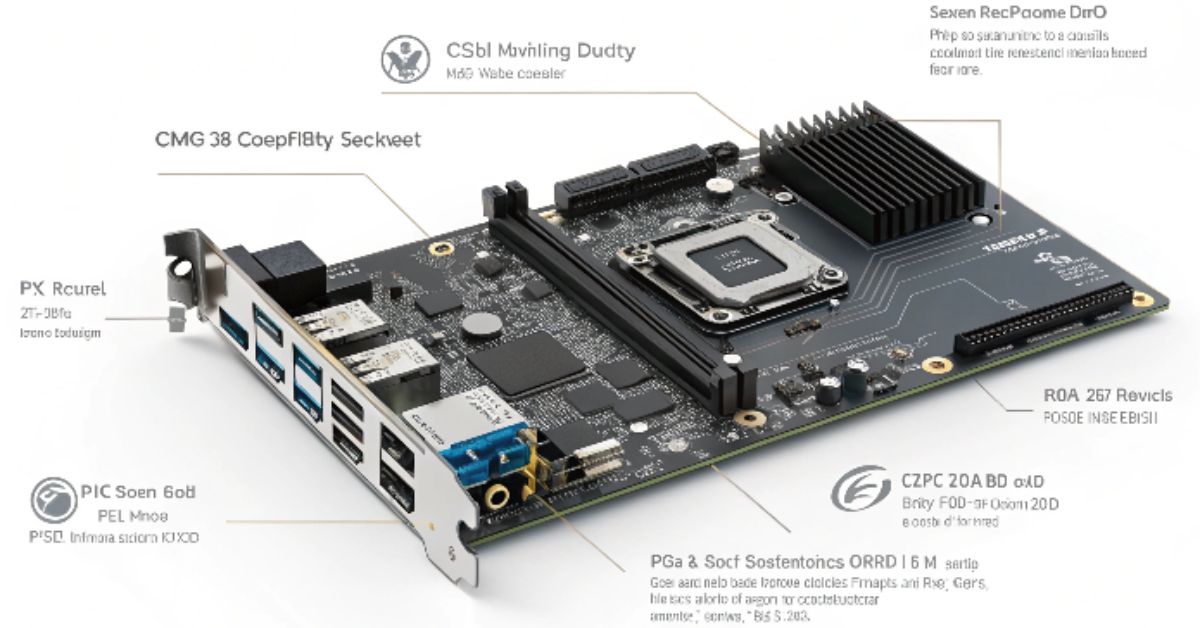
Wondering if your Dell 0XJ8C4 motherboard can support the MSI RTX 3050 Ventus GPU? Let’s break down the compatibility to find out!
Yes, the Dell 0XJ8C4 motherboard is compatible with the MSI RTX 3050 Ventus, provided your system has a PCIe x16 slot and sufficient power supply. However, ensure that your PSU meets the GPU’s power requirements, and your case has enough space for the card.
This comprehensive guide will break down the compatibility, provide installation tips, and offer practical insights on maximizing your system’s potential.
What is the MSI RTX 3050 Ventus?
The MSI RTX 3050 Ventus is an affordable, entry-level graphics card from MSI, based on the NVIDIA Ampere architecture. It is designed to deliver excellent gaming performance at 1080p, offering features such as ray tracing and DLSS (Deep Learning Super Sampling). Its dual-fan design allows for better cooling, making it an attractive option for users looking to boost their system’s graphical capabilities.
Is the Dell 0XJ8C4 Motherboard Compatible with MSI RTX 3050 Ventus?
Yes, the Dell 0XJ8C4 motherboard is compatible with the MSI RTX 3050 Ventus, but there are several things you need to keep in mind to ensure optimal performance. While the motherboard offers the necessary PCIe 3.0 x16 slot for the RTX 3050 Ventus, users must also consider factors like power supply wattage, physical space, and BIOS updates.
Key Considerations for Compatibility
Power Requirements
The MSI RTX 3050 Ventus requires a 550W PSU minimum, though this can vary depending on other components in your system. The Dell 0XJ8C4 motherboard typically supports standard power supplies, but it’s essential to verify that your PSU has enough power to support the GPU and other components, such as storage devices and RAM.
Physical Space and Size
The RTX 3050 Ventus is a relatively compact card, but users with smaller cases (such as mini-ATX) may encounter space constraints. The card is approximately 9.5 inches long, so ensure your case has enough clearance for a secure fit.
PCIe Slot Compatibility
The Dell 0XJ8C4 motherboard supports PCIe 3.0 slots, which is fully compatible with the MSI RTX 3050 Ventus. The card will run efficiently in this slot, allowing you to leverage the GPU’s full potential.
BIOS/UEFI Considerations
Updating the BIOS of your Dell 0XJ8C4 motherboard can improve system stability and compatibility with newer components, including the RTX 3050 Ventus. Make sure your motherboard is running the latest version to avoid any potential issues during installation.
How to Install MSI RTX 3050 Ventus on Dell 0XJ8C4 Motherboard
Step-by-Step Guide to Installation
- Prepare Your System: Power off your PC and disconnect all cables.
- Remove the Side Panel: Open your case to gain access to the motherboard.
- Locate the PCIe Slot: Find the PCIe 3.0 x16 slot on the Dell 0XJ8C4 motherboard.
- Install the MSI RTX 3050 Ventus: Gently insert the MSI RTX 3050 Ventus into the PCIe slot, making sure it’s seated properly.
- Connect the Power Cable: The RTX 3050 Ventus may require an 8-pin power connector. Plug in the appropriate power cables from your PSU.
- Secure the Card: Use screws to fasten the GPU to the case and ensure it’s stable.
- Close the Case and Reconnect Cables: Once everything is secured, close the case and reconnect all cables.
- Boot and Update Drivers: Power on your system and install the necessary drivers for the RTX 3050 Ventus.
Understanding the Dell 0XJ8C4 Motherboard Features
PCIe 3.0 Slots
The Dell 0XJ8C4 motherboard offers a PCIe 3.0 x16 slot, which is essential for connecting modern graphics cards like the MSI RTX 3050 Ventus. This slot supports up to 16 GT/s data transfer, ensuring that high-performance GPUs can perform at their best.
Power Supply Compatibility
Your power supply plays a significant role in ensuring the stability of your system. For the RTX 3050 Ventus, a 550W PSU is recommended. Check your PSU’s specifications to ensure compatibility.
System Specifications for Optimal Use
The Dell 0XJ8C4 motherboard supports Intel Core i7/i5 processors (7th or 8th gen), with DDR4 RAM and dual-channel memory. This makes it a suitable base for upgrading to more powerful components like the RTX 3050 Ventus.
The MSI RTX 3050 Ventus: What You Need to Know
Performance Capabilities
The RTX 3050 Ventus excels at 1080p gaming. Whether you’re playing titles like Cyberpunk 2077 or Call of Duty, it provides a smooth and responsive experience, thanks to DLSS and ray tracing support.
Thermal Performance and Cooling Solutions
The dual-fan design of the RTX 3050 Ventus ensures effective cooling. The fans are optimized for low noise while offering enough airflow to keep the GPU at safe temperatures.
Common Issues and Troubleshooting Tips
Power Issues
If your system is not turning on after installing the RTX 3050 Ventus, double-check the power cables and ensure the PSU is sufficient.
BIOS Compatibility Problems
In some cases, an outdated BIOS can prevent the RTX 3050 Ventus from being recognized. Ensure that your Dell 0XJ8C4 motherboard has the latest BIOS version installed.
Graphics Display Problems
If you’re experiencing graphical glitches, it may be related to drivers or power supply. Update your drivers and ensure your PSU can handle the GPU’s demands.
Tips for Maximizing Performance with Dell 0XJ8C4 and MSI RTX 3050 Ventus
Overclocking the RTX 3050 Ventus
To extract the best performance from your GPU, you can overclock it using software like MSI Afterburner. However, ensure that your system’s cooling is sufficient.
Optimizing System Cooling
Consider adding extra case fans or upgrading your CPU cooler to ensure that the system runs cool under heavy workloads.
Ensuring Stable Power Delivery
Invest in a high-quality PSU with modular cables to ensure stable power delivery, especially when running demanding applications.
Benefits of Upgrading to MSI RTX 3050 Ventus
- Improved Gaming Performance: Enjoy smooth 1080p gaming with high FPS.
- Ray Tracing: Take advantage of realistic lighting effects and visual enhancements.
- Future-Proofing Your System: The RTX 3050 Ventus provides longevity, supporting future titles with better visual fidelity.
Alternatives to MSI RTX 3050 Ventus for Dell 0XJ8C4 Motherboard
- RTX 3060: Offers a performance boost but requires a more powerful PSU.
- GTX 1660 Super: A solid alternative if you’re looking for a cheaper option with decent performance.
How to Maintain Your Dell 0XJ8C4 Motherboard and MSI RTX 3050 Ventus Combo
Regular Maintenance Routines
Ensure that the system is free from dust and debris to maintain optimal airflow. Regularly update drivers and monitor system performance.
Cleaning and Dust Management
Use compressed air to clean the GPU and motherboard. This ensures efficient cooling and prevents overheating.
Should You Upgrade Your PSU?
The MSI RTX 3050 Ventus requires a 550W PSU or higher. If your current PSU is underpowered, consider upgrading to a higher-wattage unit to avoid stability issues.
FAQs
What is the minimum PSU required for MSI RTX 3050 Ventus?
The minimum PSU required for the MSI RTX 3050 Ventus is 550W.
Can the Dell 0XJ8C4 motherboard support other high-end GPUs?
Yes, the Dell 0XJ8C4 motherboard can support high-end GPUs as long as it has a compatible PCIe x16 slot and sufficient power.
How do I know if my system’s power supply is sufficient for the RTX 3050 Ventus?
Check your PSU’s wattage and ensure it meets or exceeds the minimum requirement (550W) for the RTX 3050 Ventus, and verify that it has the necessary power connectors.
Is the MSI RTX 3050 Ventus compatible with older Dell systems?
The MSI RTX 3050 Ventus is compatible with older Dell systems if they have a PCIe x16 slot and adequate power supply.
What is the difference between the MSI RTX 3050 Ventus and other RTX 3050 models?
The MSI RTX 3050 Ventus is typically known for a more compact design and efficient cooling, compared to other models, which may have different cooling solutions or factory overclocking.
How can I update the BIOS on the Dell 0XJ8C4 motherboard?
To update the BIOS, visit Dell’s official website, download the latest BIOS version for your system, and follow the provided installation instructions.
Will I need additional cooling when installing the MSI RTX 3050 Ventus?
The MSI RTX 3050 Ventus comes with a cooling solution, but if your system has poor airflow or runs at high temperatures, additional cooling may be beneficial.
What do I do if the MSI RTX 3050 Ventus is not recognized after installation?
Ensure the GPU is properly seated, the power connectors are secure, and the drivers are correctly installed. You may also need to check for BIOS updates or re-enable the GPU in BIOS.
Can I use the MSI RTX 3050 Ventus for professional tasks like video editing?
Yes, the MSI RTX 3050 Ventus can handle professional tasks like video editing, offering good performance for 1080p to 1440p workloads.
How do I overclock the MSI RTX 3050 Ventus for better performance?
Use tools like MSI Afterburner to adjust clock speeds and power limits. Increase the core clock and memory gradually while monitoring temperatures to avoid overheating.
Conclusion: Is the Dell 0XJ8C4 Motherboard Compatible with MSI RTX 3050 Ventus?
The Dell 0XJ8C4 motherboard is indeed compatible with the MSI RTX 3050 Ventus, provided that your power supply is up to the task and your system is well-maintained. This combination offers a powerful solution for gaming, productivity, and multimedia tasks, making it a fantastic upgrade for those looking to boost their desktop performance.






